We were in Seoul for a week and a half.
- Gyeongbok Palace:
 This was a palace complex used by the rulers of Korea from 1395 through the 1600s. It was later all but destroyed by the Japanese during their occupation of Korea, but restoration has been making progress since 1995. It’s made up of many hanok-looking buildings which served as things like the royal receiving room, the emperor’s private quarters, the empress’ rooms, etc. The public buildings are generally pretty plain, minus the massive throne in the middle, and some vases or a bit of ceiling carving.
This was a palace complex used by the rulers of Korea from 1395 through the 1600s. It was later all but destroyed by the Japanese during their occupation of Korea, but restoration has been making progress since 1995. It’s made up of many hanok-looking buildings which served as things like the royal receiving room, the emperor’s private quarters, the empress’ rooms, etc. The public buildings are generally pretty plain, minus the massive throne in the middle, and some vases or a bit of ceiling carving. - Korean Folk Art Museum: We didn’t give this museum much of a chance, sadly, because the first exhibit we encountered was about jeans. It was described (at least in the English) as a hallmark of democratization and civilization, though we had a lot of trouble understanding what it had to do with Korean culture.
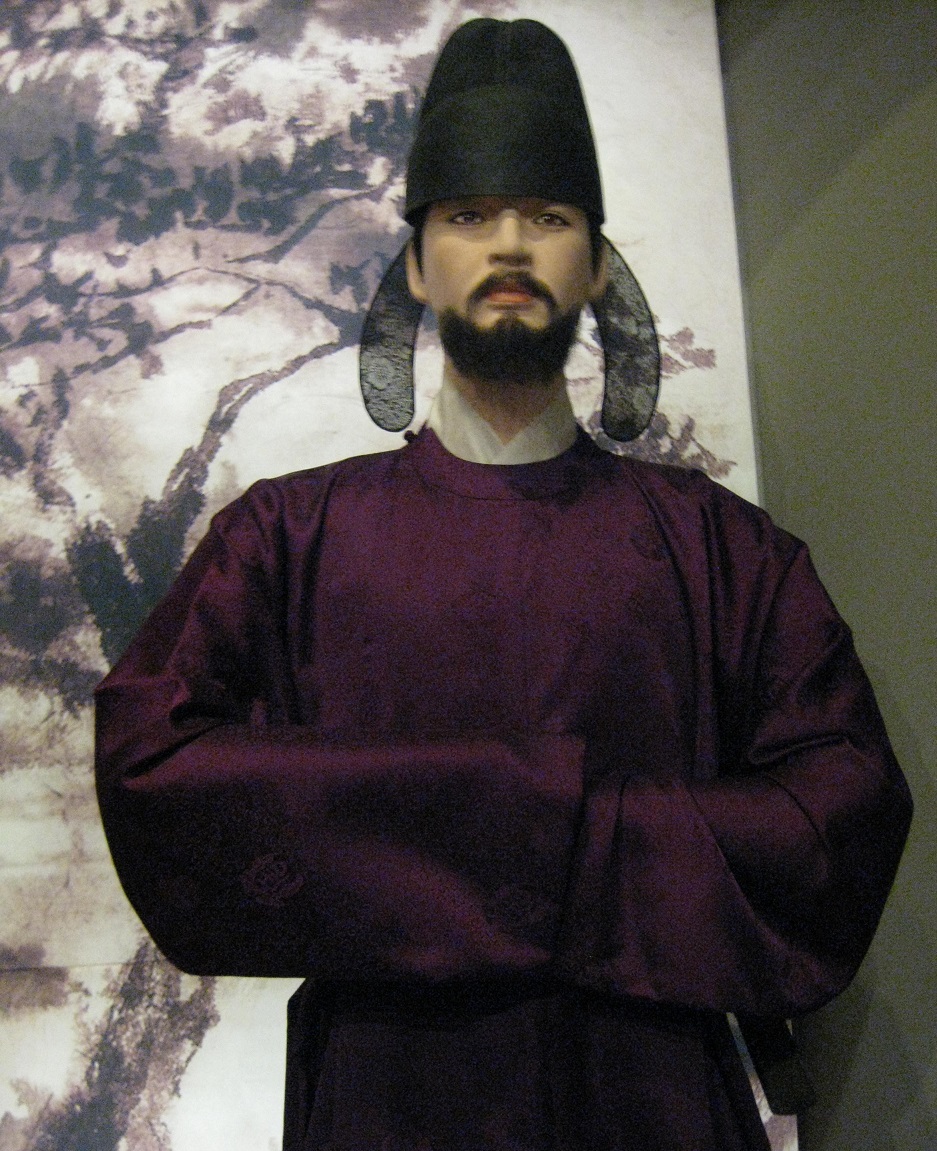 The exhibits included everything from people’s feelings on jeans (‘Jeans are my life partner,’ one man said) to a picture of the Statue of Liberty wearing jeggings (in 1978!). The second exhibit was on the history of the Korean civilization, which was more enlightening. I especially enjoyed the information about their metal printing plates and the invention of their alphabet – though the traditional outfits were cool too.
The exhibits included everything from people’s feelings on jeans (‘Jeans are my life partner,’ one man said) to a picture of the Statue of Liberty wearing jeggings (in 1978!). The second exhibit was on the history of the Korean civilization, which was more enlightening. I especially enjoyed the information about their metal printing plates and the invention of their alphabet – though the traditional outfits were cool too. - Hanoks: A hanok is a building that looks like a little palace, with fancy wooden decorations and tile work on the eaves of the building. Many are built to work with the environment around them, in a very early form of the principles used by architects like Gaudi to blend man-made and natural elements. They used to be people’s homes, but now they are mostly hotels; we went to one that was a tea house. The one we picked (Suyeon Sanbang) used to be the home of a Korean author and is in a peaceful courtyard, set back from the road. We took off our shoes when entering, and we went through the structure’s sliding door. We sat on heated mats on the floor (like sitting on a thin heating pad) at a low table, and we had different teas and cakes. I got a pumpkin pudding with red beans in it, and a friend got sticky cookies. My tea was very sweet and fruity (and hot pink), while B got one (jujube) that had a texture and color more reminiscent of soup. I don’t think it’s very true to modern Korean life, but it’s relaxing, fun, and gives you a view into traditional Korean life.
- (Cheon)ggyecheon Stream:
 This used to be a stream that ran through the city, but urban development destroyed it. As a purposeful – and quite expensive – urban renewal project, the city spent the equivalent of almost one billion US dollars to put the stream back in. Now, it’s a three-foot deep waterway about fifteen feet below street level in a district of skyscrapers. There are artificial stepping stones, a few waterfalls, a wishing well, and warnings to evacuate the area if it floods. When we visited, there was even a photography exhibit under one of the bridges, featuring photos from Venice, SE Asia, Cusco, and Paris. It’s a nice little area, but I wouldn’t prioritize the visit unless you’re in the area.
This used to be a stream that ran through the city, but urban development destroyed it. As a purposeful – and quite expensive – urban renewal project, the city spent the equivalent of almost one billion US dollars to put the stream back in. Now, it’s a three-foot deep waterway about fifteen feet below street level in a district of skyscrapers. There are artificial stepping stones, a few waterfalls, a wishing well, and warnings to evacuate the area if it floods. When we visited, there was even a photography exhibit under one of the bridges, featuring photos from Venice, SE Asia, Cusco, and Paris. It’s a nice little area, but I wouldn’t prioritize the visit unless you’re in the area. - Bosingak: This is Seoul’s Liberty Bell… kind of. There has been a city bell since the Josean Dynasty in the 1300s: it used to toll the opening and closing of the city gates and warn of things like fires. Sadly, this did not prevent its housing pagoda from being burned down multiple times. Since that time, the bell was moved (to here) and recast (twice), so that the bell on display is only from 1979; the one cast before is in the National Museum. Moreover, you can’t actually get close to the bell, on account of the guards out front. Given all that, you might wonder why anyone visits at all. Well, in 1919, this is where South Korea’s Declaration of Independence was signed, proclaiming their freedom from Japan’s occupying forces. So, it’s like the country’s Liberty Bell and Independence Hall, wrapped in one. Fun to photograph, but don’t go out of your way unless you’re a history buff.
- City Hall: This area is interesting for a few reasons. First, it has an unusual mix of modern skyscrapers, like the Broadcasting Tower, and old-fashioned buildings, like the Deoksugung (Palace). From what I understand, the City Hall building itself has those two parts: one gleaming glass and the other marble column. Also interesting are the peaceful protests outside the building; there were at least two when we were there. One was a labor protest, while the other opposed the mayor’s plan to add protections for sexual orientation. The former group was singing a song eerily reminiscent of a patriotic Russian song from my childhood, while the latter was pretty militantly angry. Recalling the State Department’s exhortation that US travelers avoid civil unrest, we hightailed it out of there.
- N Seoul Tower:
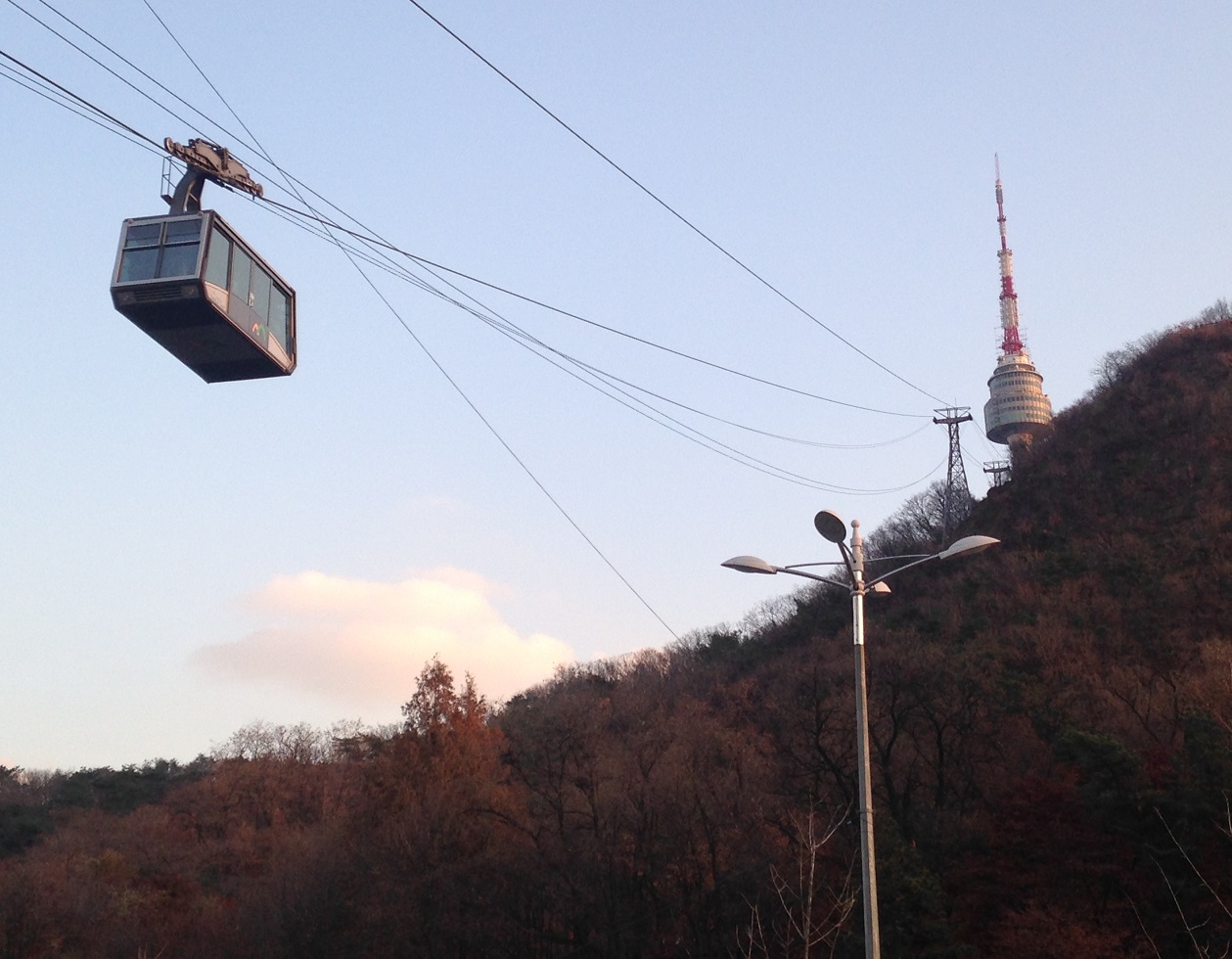 This is the tallest point in Seoul, with a big observation deck on top. Tickets aren’t super expensive, compared to similar attractions, like the Sears Tower in Chicago or the Shard in London. Most people take a cable car up and back, though we actually walked up a ton of stairs to get there. The view of the city is great, whether from the overlooks or from the Tower itself. There are a ton of bells and whistles too: a huge fence to which people clip locks; a daily 3 pm cultural demonstration of drums, swords, and traditional costumes; every kind of food, from Coldstone Creamery to traditional Korean (all overpriced, as expected); a pagoda; a place to send postcards from ‘the highest post office in the world’ – and more. Worth a visit, I think, especially if you walk up. And I don’t just say that to subject you to our pain.
This is the tallest point in Seoul, with a big observation deck on top. Tickets aren’t super expensive, compared to similar attractions, like the Sears Tower in Chicago or the Shard in London. Most people take a cable car up and back, though we actually walked up a ton of stairs to get there. The view of the city is great, whether from the overlooks or from the Tower itself. There are a ton of bells and whistles too: a huge fence to which people clip locks; a daily 3 pm cultural demonstration of drums, swords, and traditional costumes; every kind of food, from Coldstone Creamery to traditional Korean (all overpriced, as expected); a pagoda; a place to send postcards from ‘the highest post office in the world’ – and more. Worth a visit, I think, especially if you walk up. And I don’t just say that to subject you to our pain. - Korean Demilitarized Zone (DMZ):
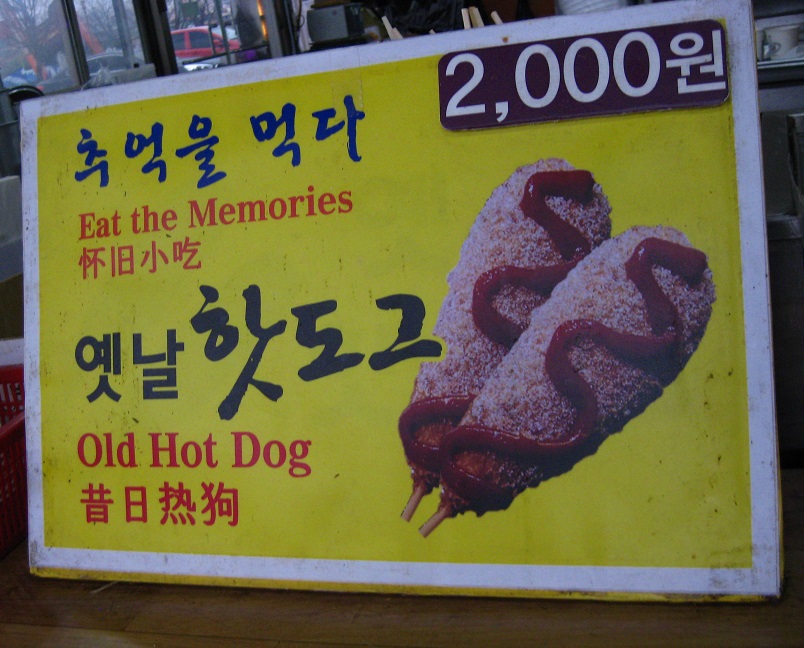 The day on which we toured the DMZ was quite fitting for the subject matter: rainy, foggy, and generally dreary. We went on a bus tour, with a pile of foreigners, from Dutch to Singaporean citizens. First, the tour stopped at a rest area, where you could see a peace bridge built by the owner of Hyundai, a peace bell, a peace wall with rocks from areas of major wars/battles, and non-peace-related snacks. B got one that was labeled ‘Old Hot Dog,’ though we saw the owner finish frying the corn-dog-looking treat right in front of us. Next, we went to a visitors center, which featured museum-like exhibits and an 8-minute video with nifty graphics of things blowing up. The narration was especially funny for its ridiculous contradictions, like how ‘until the re-unification of Korea, the DMZ will remain forever’ or how it’s an area of peaceful life for birds and wildlife, right after showing the million land mines sprinkled in the area.
The day on which we toured the DMZ was quite fitting for the subject matter: rainy, foggy, and generally dreary. We went on a bus tour, with a pile of foreigners, from Dutch to Singaporean citizens. First, the tour stopped at a rest area, where you could see a peace bridge built by the owner of Hyundai, a peace bell, a peace wall with rocks from areas of major wars/battles, and non-peace-related snacks. B got one that was labeled ‘Old Hot Dog,’ though we saw the owner finish frying the corn-dog-looking treat right in front of us. Next, we went to a visitors center, which featured museum-like exhibits and an 8-minute video with nifty graphics of things blowing up. The narration was especially funny for its ridiculous contradictions, like how ‘until the re-unification of Korea, the DMZ will remain forever’ or how it’s an area of peaceful life for birds and wildlife, right after showing the million land mines sprinkled in the area. 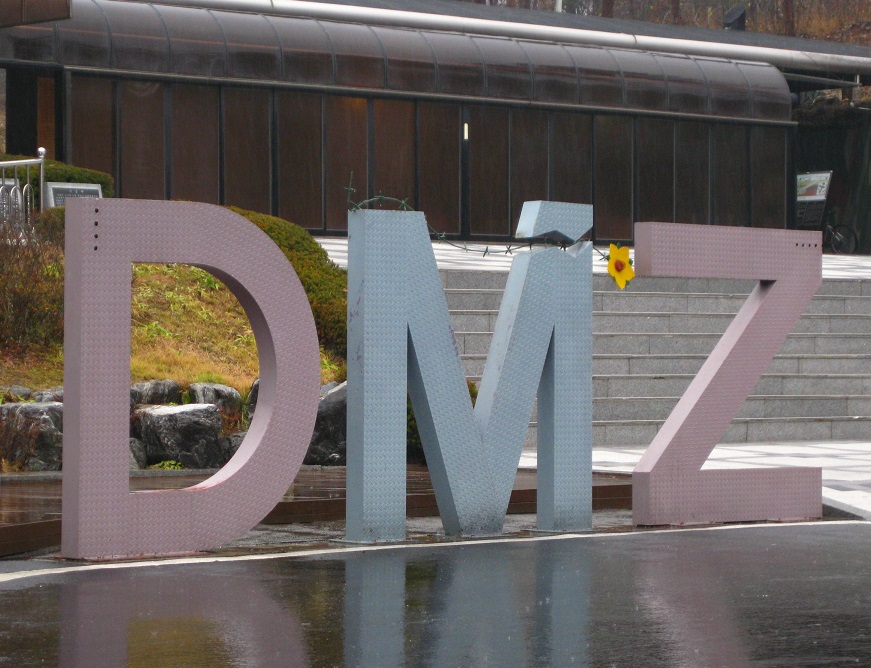 After that, we toured one of the four discovered tunnels that the North Koreans built to invade South Korea. The most recent one was discovered as recently as 1990! We walked down the incline into the tunnel, wearing yellow hard hats to avoid hitting our heads on the low beams; B had to walk with his head completely sideways, but with my height, this was entirely unnecessary. Not only could you see the holes where North Koreans had dynamited to build the tunnel, but you could also see coal smeared on the walls, to support the patently ridiculous North Korean claim that it was an old coal mining tunnel. After the aerobic walk back up to the gift shop, we proceeded to the Observation Tower. Given the fogginess, the most exciting visual was of the labeled photo, showing the intended view. Finally, we visited the train station which was to connect South Korea to the rest of the Eurasian railway – but which is inactive, because North Korea won’t let anything pass through it. In sum, everyone survived and was summarily depressed by the North Koreans’ continued aggression.
After that, we toured one of the four discovered tunnels that the North Koreans built to invade South Korea. The most recent one was discovered as recently as 1990! We walked down the incline into the tunnel, wearing yellow hard hats to avoid hitting our heads on the low beams; B had to walk with his head completely sideways, but with my height, this was entirely unnecessary. Not only could you see the holes where North Koreans had dynamited to build the tunnel, but you could also see coal smeared on the walls, to support the patently ridiculous North Korean claim that it was an old coal mining tunnel. After the aerobic walk back up to the gift shop, we proceeded to the Observation Tower. Given the fogginess, the most exciting visual was of the labeled photo, showing the intended view. Finally, we visited the train station which was to connect South Korea to the rest of the Eurasian railway – but which is inactive, because North Korea won’t let anything pass through it. In sum, everyone survived and was summarily depressed by the North Koreans’ continued aggression. - Bongeunsa Temple: This
 is a beautiful Buddhist temple that I visited after the Kimchi Museum turned out to be a bust. It has been in this location since the 700s, though many skyscrapers have shot up around it – making it look both anachronistic and very cool. It is an active prayer site consisting of about a dozen pagoda-like buildings. You enter through the Gate of Suchness, which I initially mis-read as ‘Gate of Success;’ I should have known better, given the nature of Buddhism. As people walked in – and out, they bowed to the Two Celestial King statues on the left, to the two on the right, and to the front of the temple. After walking through the gates, you first enter the biggest hall, the ceiling of which was covered in red paper lanterns; it looked very cool. Next was a building in which people were praying, next to which was a pagoda for the Diety of Death. Up on a hill, overlooking the city, were a Shrine to the Arctic and one called Vulture Peak. All of these pagodas had beautiful painted scenes on their sides, in addition to the roof eave decorations that Korean palaces and pagodas also have. There is also a giant Buddha sculpture in an open plaza, and a small statue to the Diety of Compassion, who takes all suffering upon himself. I liked many of these ideas, and the quiet peacefulness of the Temple was amazing, given its location. Worth a visit, in my opinion.
is a beautiful Buddhist temple that I visited after the Kimchi Museum turned out to be a bust. It has been in this location since the 700s, though many skyscrapers have shot up around it – making it look both anachronistic and very cool. It is an active prayer site consisting of about a dozen pagoda-like buildings. You enter through the Gate of Suchness, which I initially mis-read as ‘Gate of Success;’ I should have known better, given the nature of Buddhism. As people walked in – and out, they bowed to the Two Celestial King statues on the left, to the two on the right, and to the front of the temple. After walking through the gates, you first enter the biggest hall, the ceiling of which was covered in red paper lanterns; it looked very cool. Next was a building in which people were praying, next to which was a pagoda for the Diety of Death. Up on a hill, overlooking the city, were a Shrine to the Arctic and one called Vulture Peak. All of these pagodas had beautiful painted scenes on their sides, in addition to the roof eave decorations that Korean palaces and pagodas also have. There is also a giant Buddha sculpture in an open plaza, and a small statue to the Diety of Compassion, who takes all suffering upon himself. I liked many of these ideas, and the quiet peacefulness of the Temple was amazing, given its location. Worth a visit, in my opinion. - Norebang: This is the Korean word for karaoke. We got a room for a half hour (they gave us an extra 12 minutes free), and it wasn’t much different from having gone in Berkeley for B’s birthday last year. Except that the TV controls were in Korean only, so changing the volume was an adventure in and of itself. And the next morning, I woke up with ‘Bye Bye Bye’ in my head.
- Tteok (Rice Cake) Museum: Though we didn’t hate it, I would not recommend this museum. It’s a two-room museum with glass displays showing different types of rice patties. They somehow managed to make us hungry, despite the fact that we had just eaten and that they were made out of something that looked like Play-doh. Learning about the different occasions for which these rice dishes would be made – from weddings to 100-days old celebrations – was the highlight. The cafe downstairs had lots of (sweet) rice cakes. Sadly, they looked better than they tasted; shocking, given my love of rice and desserts.
- Puppy Cafe: Seoul
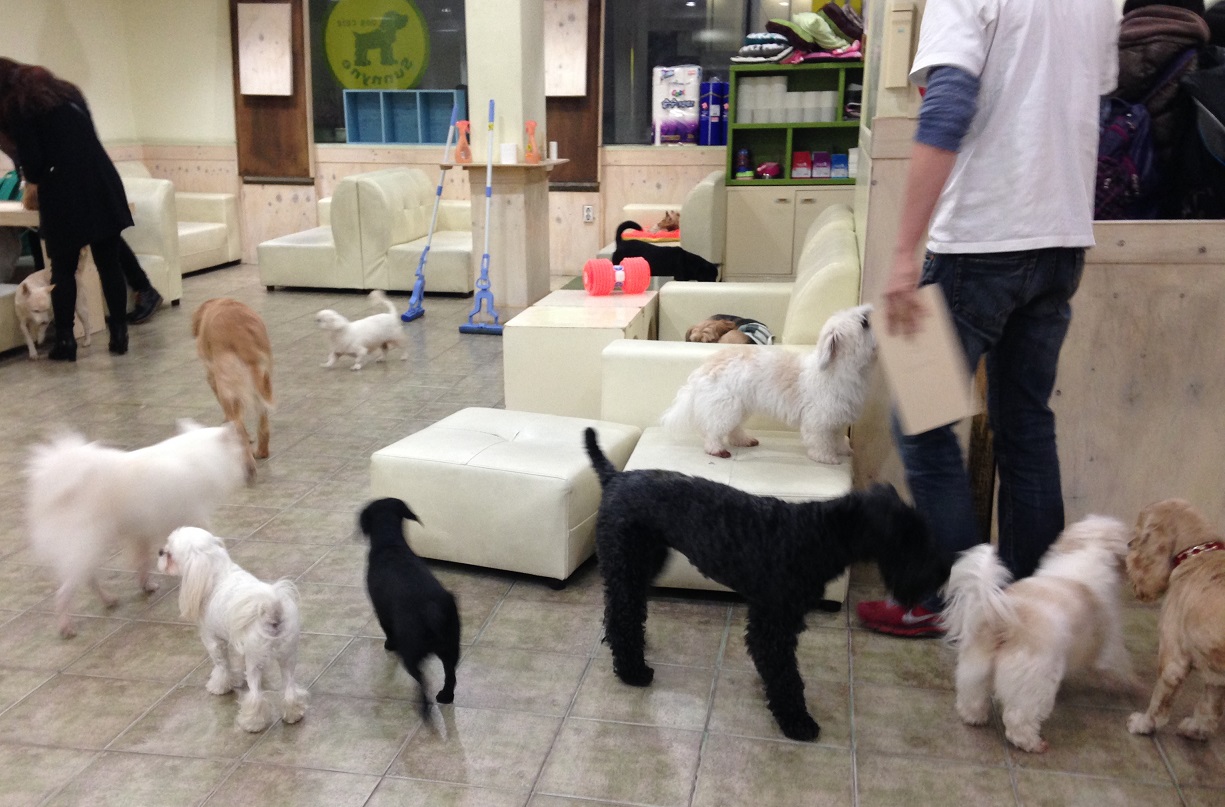 has a ton of themed cafes, including ones in which you can play with cats or with dogs. Because apartments are so small, many people can’t have pets, so they come to places like this to get their fix. The coffee and tea is vastly overpriced, of course, but you can sit and pet the dogs for hours. (Puppy is a bit of a misnomer, as almost all the dogs we saw were adults.) They keep the place pretty clean, though they do let the dogs up on the tables; there are even lint rollers for your clothes. Though animals don’t generally love me, I made a dog friend who liked sitting in my lap and being petted so much that he nipped at B as he was moving him so I could get up. A few of the smaller dogs were prone to snipping, while the gigantic Great Dane (about three times my size) was calm. Worth the visit!
has a ton of themed cafes, including ones in which you can play with cats or with dogs. Because apartments are so small, many people can’t have pets, so they come to places like this to get their fix. The coffee and tea is vastly overpriced, of course, but you can sit and pet the dogs for hours. (Puppy is a bit of a misnomer, as almost all the dogs we saw were adults.) They keep the place pretty clean, though they do let the dogs up on the tables; there are even lint rollers for your clothes. Though animals don’t generally love me, I made a dog friend who liked sitting in my lap and being petted so much that he nipped at B as he was moving him so I could get up. A few of the smaller dogs were prone to snipping, while the gigantic Great Dane (about three times my size) was calm. Worth the visit! - Gwangjang Market: This is a fabulous market. There are over 5,000 stalls or stores! Many of them sell bolts of cloth, though there are also shoes, purses, ready-made clothing, and even Western toiletries. (I finally found Vaseline in a container smaller than a baby horse!) Then, there is a large food area, which has dozens of stalls, grouped by type: the pig feet/snouts/sausage ones, the dumpling and soup ones, the fried veggie pancake ones, the live fish ones, etc. The women working the stalls encourage each passerby to sit down on the benches in front of them, and they dish up their fare while calling out to the next person.
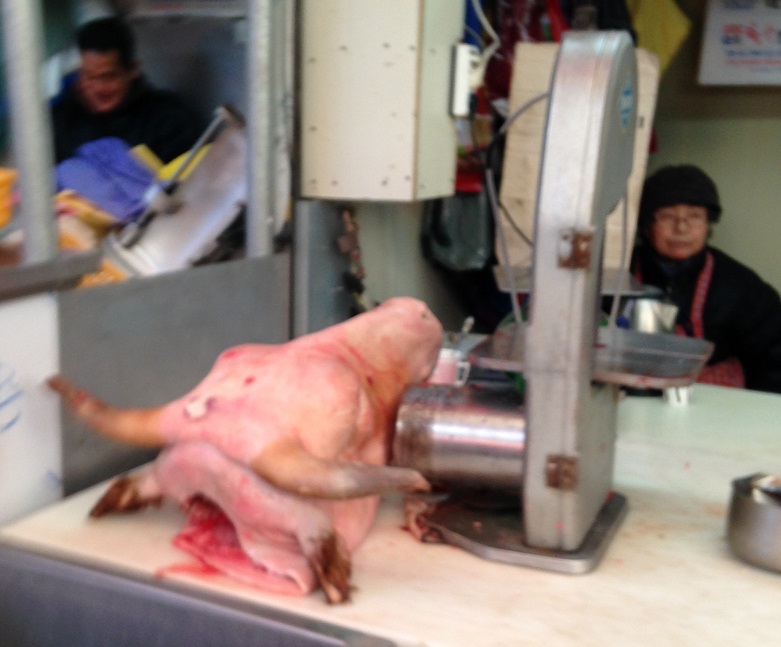 They say that this is the traditional Korean way, and I think it is very fun to watch.
They say that this is the traditional Korean way, and I think it is very fun to watch. - Meat Market: We came to the neighborhood to have good Korean BBQ – which, by the way, is not so much BBQ as grilling of meat on a tabletop mini griddle. To get there, we walked through this, the largest meat market in Korea. As expected, the ground was covered in meat juices, and there were a million stands selling every kind of animal. Pig feet and heads I expected, but I almost jumped when we first passed a bull head because it was so huge. Unless you want to see the innards and unknown body parts of cows, pigs, and more, you may not want to come here.
Things We Skipped:
- Kimchi Museum: I made quite the effort to go here. I trekked all the way out to this area on the other side of town from us, only to find out that the museum is closed for renovations until March 2015. It’s supposed to be a small, but unique museum, and I was excited to learn about all things kimchi. Alas.
- Handbag Museum: B was super not into this museum (can’t imagine why), and the site made me feel like a bull in a china shop, so we opted out.
- Trick Eye Museum: There are actually two museums like this in Seoul. You have to love taking photos to go, because that’s pretty much all it is: a place to photograph yourself with optical illusions. It didn’t seem like that much fun.
- Leeum Samsung Museum of Art: We didn’t quite make it here.
- Museum of Chicken Art: This sounded highly entertaining, since it was art of chickens, in various mediums. Unfortunately, we ran out of time.
- Nostalgia Museum: We had trouble finding this museum of Korean artifacts from the 60s, 70s, and 80s. It turned out that we had walked past it, but we didn’t know. Alack.
- Korea Stamp World: Though the stamp museum in Dublin was interesting, we didn’t have much time to see this one. There’s not much information about it online (in English), surprisingly.
- Lotte World: I am not that amused by indoor amusement parks sponsored by department store companies.
- Bukhansan or Ansan Mountain: It was cold, and we already did two ‘mountain’ hikes in Seoul.
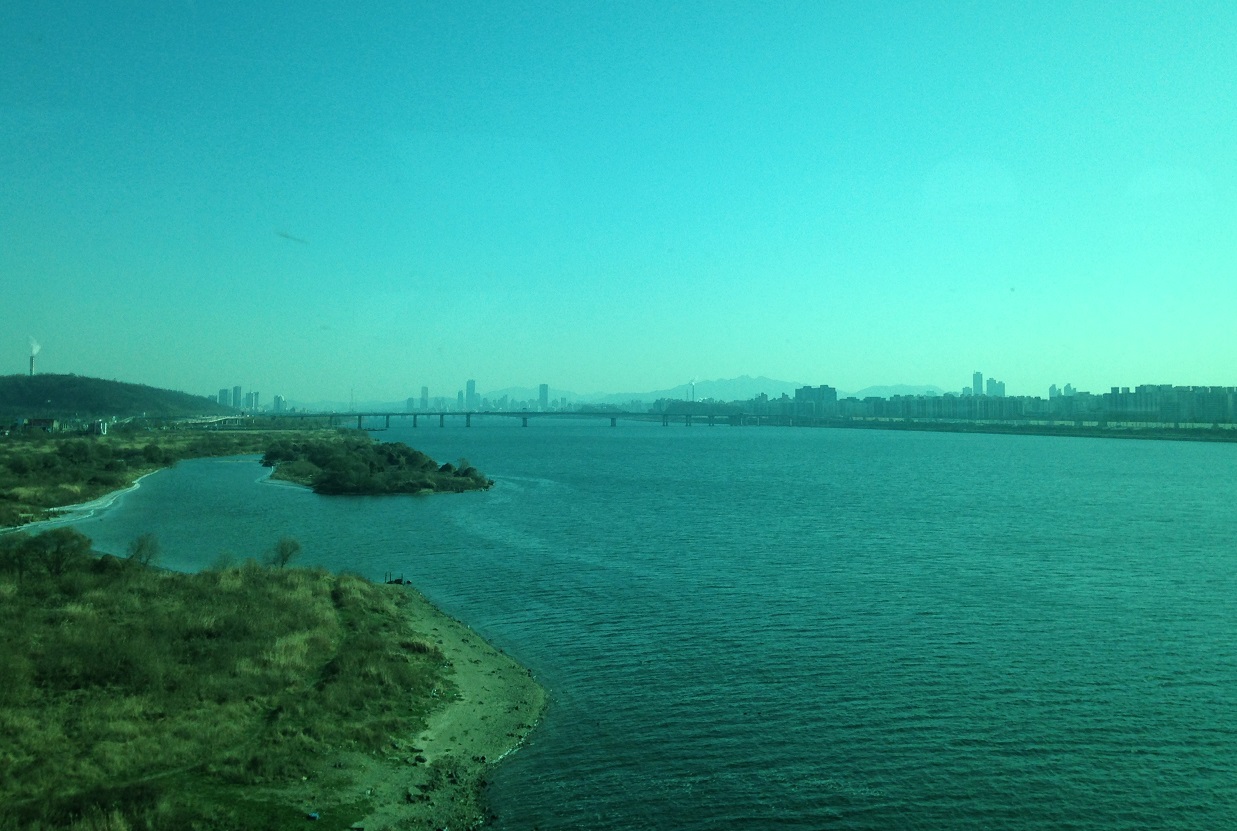
- Han River: Definitely too cold. We did ride over it on the subway though.
- Silent Disco: There wasn’t one going on while we were in town, unfortunately.
- Dialogue in the Dark: Unless we had a group of English-speaking tourists with us, we would have paid $120 each. No thank you.
- Nanta Show: This sounded a lot like a cooking-focused Blue Man Group. It was a bit on the expensive side, and we didn’t go early enough – when it was still warmer.
- Korean Spa: We went and got regular massages instead, though this sounded fun.
- Noryangjin Fish Market: I was a bit sad to miss this market, where fish is sold wholesale, at 1 to 6 am auctions. B was creeped out by the idea of pointing to a fish and having the shop keeper kill it for you to eat right then.



Pingback: What Is Korean Food, Anyway? - Novelty Buffs
Pingback: Memorable Moments in Korea - Novelty Buffs
Pingback: What We Saw in Singapore - Novelty Buffs